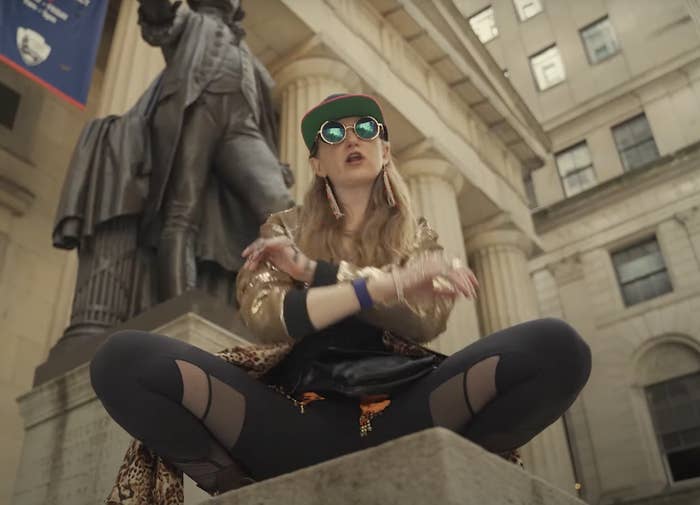
New York City workers opposed to Covid vaccine mandates march across the Brooklyn Bridge carrying giant US and Canadian flags

A protester stands with a Canadian flag near the parliament building in Wellington during a demonstration against Covid restrictions

Anti-Covid mandate protestors hold a sign reading "Freedom" and a Canadian flag in Ottawa

City workers protest against Covid-19 vaccine mandates and restrictions in New York City

Protesters stand on an overpass to welcome a protest convoy of trucks and other vehicles in Wellington, New Zealand

The front gate of the Canadian parliament is covered with banners protesting vaccine mandates
A protest movement by Canadian truckers angered over Covid vaccine rules has become a rallying point for opponents of pandemic restrictions, firing up crowds from New York to New Zealand.
In New York, dozens of municipal workers facing dismissal unless they get shots marched across the Brooklyn Bridge to City Hall on Monday carrying giant US and Canadian flags.
"Unvaccinated Lives Matter" and "Workers Are Essential, Mandates Are Not," read signs carried by the crowd, which included firefighters and teachers.
In New Zealand, inspired by the Canadian "Freedom Convoy," trucks and campervans blocked streets near parliament in Wellington on Tuesday to protest against Covid restrictions and vaccinations.
Hundreds of vehicles plastered with messages such as "Give Us Back Our Freedom" parked in streets surrounding the parliament building.
Others drove around the city center with horns blaring as over 1,000 protesters on foot listened to speeches.
"I'm actually vaccinated but I'm against mandating people to be vaccinated," said Stu Main, of Wellington. "I think it's disgraceful, forcing vaccination on people who don't want it."
Several Wellington protesters carried Canadian flags, including an expatriate named Billy, who declined to give his surname.
"I'm just supporting the brothers in Canada, fighting for freedom over there," he said.
The Canadian protests have often tapped into right-wing politics, with Donald Trump flags at rallies and huge interest on conservative online sites.
- Calls for rallies in France -
In France, calls were circulating on Facebook for protestors to descend on Paris for anti-mandate demonstrations this weekend.
Similar appeals were launched in Belgium.
Some of the most vociferous support for the Canadian demonstrators has come from Republican officials in the United States, where Covid mask and vaccination mandates have become a highly partisan issue.
"The Freedom Convoy is peacefully protesting the harsh policies of far left lunatic Justin Trudeau who has destroyed Canada with insane Covid mandates," former president Trump said.
"Now, thankfully, the Freedom Convoy could be coming to DC with American Truckers who want to protest (President Joe) Biden's ridiculous Covid policies," he said in a statement.
There has been no protest in Washington so far, but more than 100 truck drivers in Alaska drove from Anchorage to Eagle River on Sunday to support the Canadian demonstrators, the Anchorage Daily News reported.
Alaska Senator Dan Sullivan, a Republican, addressed a rally in Eagle River, ADN said, telling the crowd he did not believe the federal government "has the power to look at American citizens and say 'either you get vaccinated or you get fired from your job.'"
According to the US Centers for Disease Control, fully vaccinated people are significantly less likely to die of the disease than non-vaccinated people.
Several Republican officials in US states have called meanwhile for investigations into GoFundMe after the fundraising site stopped taking donations for the "Freedom Convoy" protest.
GoFundMe removed the "Freedom Convoy" donation page on Friday, claiming it violated the site's terms of service that "prohibit user content that reflects or promotes behaviour in support of violence."
GoFundMe said it would refund all of the donations.
After the GoFundMe cutoff, organizers launched a donation drive on GiveSendGo, which describes itself as the "leader in Christian fundraising." More than $6.3 million has been raised on GiveSendGo as of Tuesday.
- Spreading protests -
The "Freedom Convoy" demonstrations began January 9 in western Canada as protests by truckers angry with vaccine requirements when crossing the US-Canadian border.
They have since morphed into broader protests against Covid restrictions and Prime Minister Justin Trudeau's government.
Trudeau demanded an end on Monday to the protest that has paralyzed Ottawa, saying "It has to stop."
"This pandemic has sucked for all Canadians," he said. "But Canadians know the way to get through it is continuing to listen to science, continuing to lean on each other."
cl/bgs










